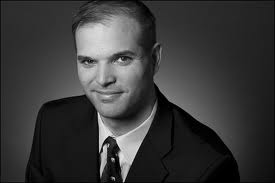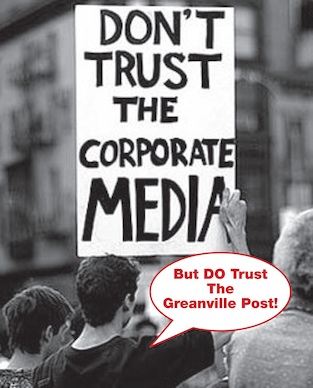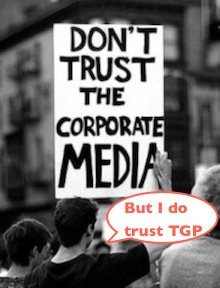ARTHUR SILBER: Matt Taibbi—et tu liberal?
Hardhitting, Dissenting Journalism — Without the Hardhitting, Dissenting Part
Taibbi posted this entry yesterday: “Another March to War?” His remarks deal with the major media’s warmongering about Iran and the distortions they rely upon. All true, and all old news to those who’ve been awake however briefly in recent years. Note what he drops into the middle of his discussion:
from November 2006. That entry offered excerpts from Hampton Sides’ book, Blood and Thunder: An Epic of the American West. Sides writes:
The mission on which Kearny led the Army of the West [in 1846] had no precedent in American history. For the first time the U.S. Army was setting out to invade, and permanently occupy, vast portions of a sovereign nation. It was a bald landgrab of gargantuan proportions.
…
Realizing that neither diplomacy nor outright bartering would achieve his expansionist ends, Polk was determined to provoke a war. He dispatched Gen. Zachary Taylor to disputed territory, between the Nueces and the Rio Grande, in southern Texas. It was an unsubtle attempt to create the first sparks. In April 1846, Taylor’s soldiers were fired upon, and Polk was thus given the pretext he needed to declare war.
“American blood has been spilled on American soil,” Polk spluttered with righteous indignation, neglecting to mention that Taylor had done everything within his power to invite attack, and that anyway, it wasn’t really American soil–at least not yet. Mexico had “insulted the nation,” the president charged, and now must be punished for its treachery, beaten back, relieved of vast tracts of real estate it was not fit to govern.
The simple truth was, Polk wanted more territory. No president in American history had ever been so frank in his aims for seizing real estate. …
Perhaps to dignify the nakedness of Polk’s land lust, the American citizenry had got itself whipped into an idealistic frenzy, believing with an almost religious assurance that its republican form of government and its constitutional freedoms should extend to the benighted reaches of the continent then held by Mexico, which, with its feudal customs and Popish superstitions, stood squarely in the way of Progress. To conquer Mexico, in other words, would be to do it a favor.
We might also mention America’s deliberate and carefully calculated decision to embark upon an overseas Empire — with the annexation of Hawaii, followed by the occupation and war in the Philippines.
And so on and so forth. In “The Slaughter of the Diseased Animals,” I described this repeated pattern. In discussing the torments inflicted by Israel on the prisoners of Gaza, I wrote:
For a very long time, the United States government has specialized in the pattern pursued by Israel. The vastly more powerful nation wishes to act on a certain policy — almost always territorial expansion, for purposes of access to resources, or to force itself into new markets, or to pursue the evil notion that economic and ideological success depend on brutality and conquest — but a specifically moral justification for its planned actions does not lie easily to hand.
So the powerful nation embarks on a course designed to make life intolerable for the country and/or those people that stand in its way. The more powerful nation is confident that, given sufficient time and sufficient provocation, the weaker country and people will finally do something that the actual aggressor can seize on as a pretext for the policy upon which it had already decided. In this way, what then unfolds becomes the victim’s fault.
The United States government has utilized this tactic with Mexico, to begin the Spanish-American War, even, dear reader, in connection with the U.S. entrance into World War II, most recently in Iraq, possibly (perhaps probably) with Iran in the future, and in numerous other conflicts. It’s always the fault of the other side, never the fault of the United States itself. Yet the United States has always been much more powerful than those it victimizes in this manner. The United States always claims that its victims represented a dire threat to its very survival, a threat that must be brought under U.S. control, or eliminated altogether. The claim has almost never been true. This monstrous pattern is “The American Way of Doing Business.”
This preview turned out to be longer than I had anticipated. Taibbi made it necessary — for he is not merely “mistaken” (pity the poor child). Rather, he appears to have missed all of American history, as well as the stratagems utilized by the powerful throughout all of history whenever they seek to increase their power still more.
But Taibbi tells us he “ha[s] to believe” in the Eden of his concocted fantasy, and that he “ha[s] to believe” in an America that never existed then and that has never existed at all. That is because he has absorbed every critical element of American exceptionalism, and he seems to lack even the faintest understanding of the false set of beliefs to which he clings so desperately.
So Taibbi is inexorably led to call Ahmadinejad “nuts,” and to proclaim that this “nut” must “definitely” not be “allowed” to have nuclear weapons. The propagandists in the media and in Washington are laughing with delight, for they could not ask for more. With opposition and dissent like this, they can begin the next war this afternoon, and nothing will stand in their way.
But some of us are not laughing. No, we most certainly are not.
—Arthur Silber publishes the ONCE UPON A TIME / POWER OF NARRATIVE blog .
_______________________________________________________________________________
¶
ADVERT PRO NOBIS
IF YOU CAN’T SEND A DONATION, NO MATTER HOW SMALL, AND YOU THINK THIS PUBLICATION IS WORTH SUPPORTING, AT LEAST HELP THE GREANVILLE POST EXPAND ITS INFLUENCE BY MENTIONING IT TO YOUR FRIENDS VIA TWEET OR OTHER SOCIAL NETWORKS! We are in a battle of communications with entrenched enemies that won’t stop until this world is destroyed and our remaining democratic rights stamped out. Only mass education and mobilization can stop this process.
It’s really up to you. Do your part while you can. •••
Donating? Use PayPal via the button below.
THANK YOU.
____________________________________________________________________________________________________








![lasswell[1]](https://www.greanvillepost.com/wp-content/uploads/2012/02/lasswell1.jpg)







